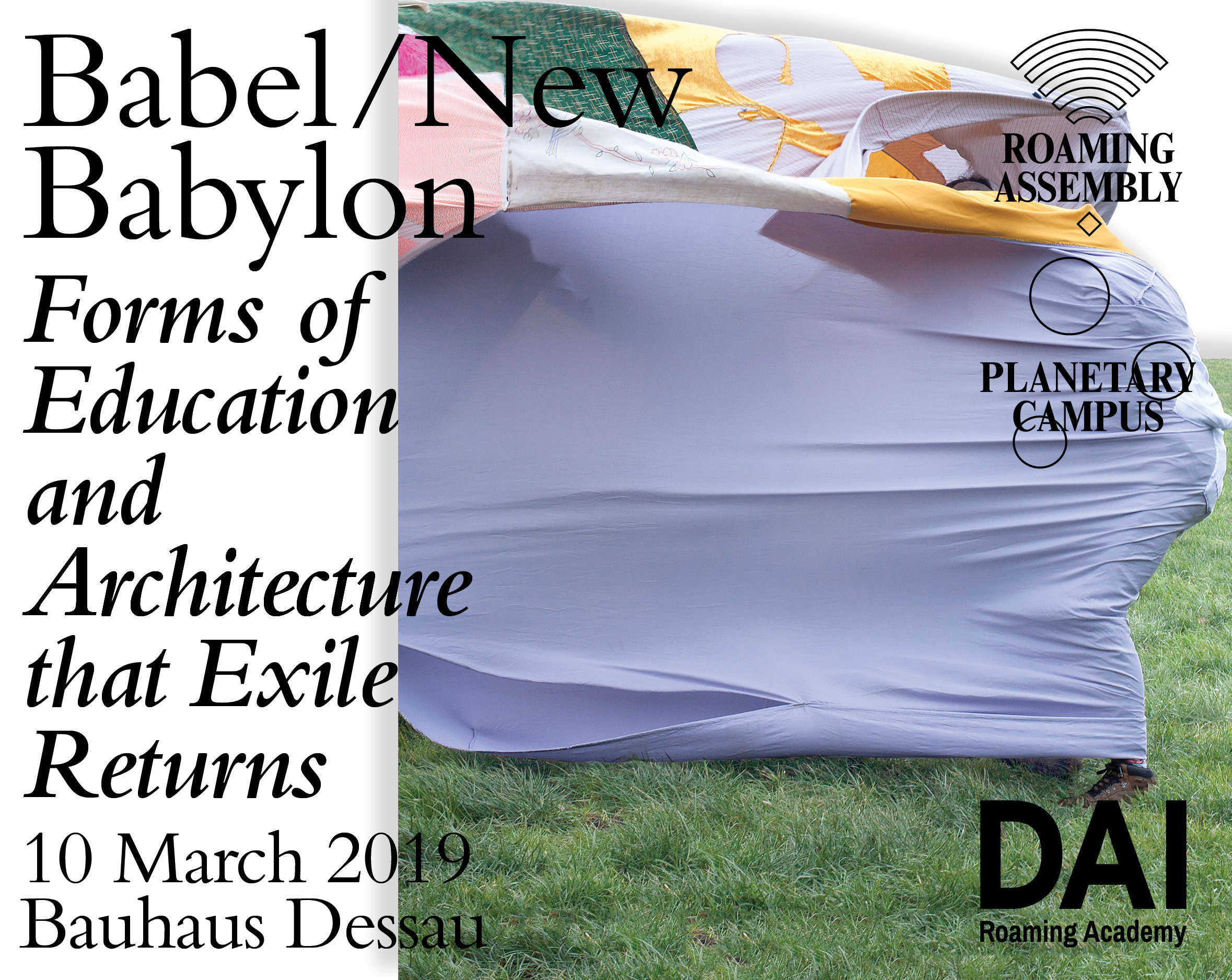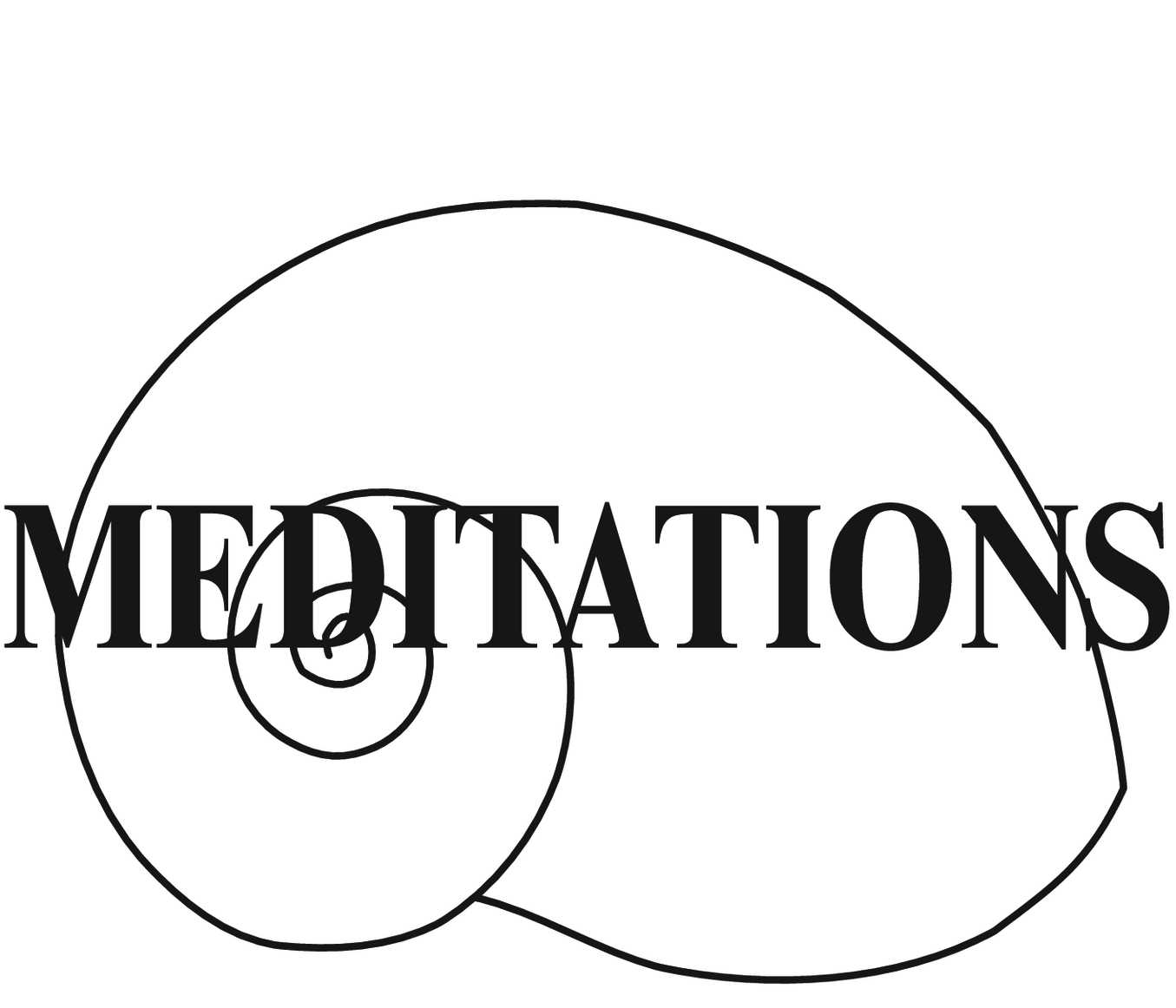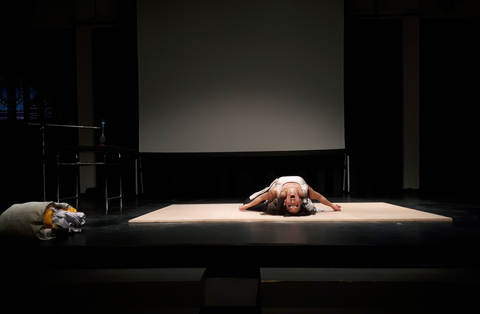2019 ~ Meditations #3 ~ Georgios Papadopoulos
Report on Roaming Assembly#23 ~ Babel/New Babylon; Forms of Education and Architecture that Exile Returns
The idea a planetary campus as it is realized by the Dutch Art Institute (DAI) is a radical experiment in learning; by abandoning the Academy as a building and as a set of predetermined and relatively stable protocols, DAI has decided to bring the educational process in the public space roaming between cities, institutions, practices and ideas. The 23rd Roaming Assembly Babel/New Babylon, which speculated on the Forms of Education and Architecture that Exile Returns[1]could be interpreted as a self-reflexive exercise of the potentialities of the nomadic condition in education and the network of the different theoretical and practical lines of flight that describe it. The fact that the assembly took place in the Auditorium of the Bauhaus Academy in Dessau and its coinciding with the movement’s centenary added to the resonance of the assembly’s speculative exercise. Bauhaus epitomizes rationality and functionalism in Architecture and the Arts, symbolizing one of the cultural peaks of Modernity. This affinity of Bauhaus to Modernity and especially its attachment of late to productivism – especially under Max Bill – created opposition the most vocal of which voiced from the Experimental Laboratory of the Imaginist Bauhaus in Alba, founded by Giuseppe Pinot-Gallizio and Asger Jorn in 1955. Subsequently, the two of them organized the First World Congress of Free Artists that lead to the foundation of the Situationist International (IS) and produced a new avant-garde that combined revolutionary politics with aesthetics and experimental urbanism. The motivation of the Imaginists Bauhaus Laboratory to retrieve materiality from the functionalism and productivism of the post-WWII era was one of the sources of inspiration of DAI’s Roaming Assembly in Dessau, as was the project of the Situationists that built on the legacies of Pinot-Gallizio and Jorn. On the first act of the assembly as well as on the last, Javiera de la Fuente affirmed the importance of Situationism for the project, in a prolific performance that employed Flamenco to convey some of the most resonant statements of the emblematic text of the IS, On the Poverty of Student Life. The assembly’s occupation with experimental education was contextualized by a written intervention by one of the original members of IS, Raoul Vaneigem[2], which was read collectively towards the end of the session. The aim of this short report is to rethink and built upon these gestures of critique touching upon the main questions raised in the assembly, namely nomadism as a state of self-imposed exile, Situationism and psychogeography, wandering as a methodology of research and an aesthetic practice, the limits of language and finally flamenco as a machine for living.
Immediately after Javiera de la Fuente’s performance of the phrases of the IS, Maria Garcia extrapolated on the project Machines for Living that motivated the flamenco performance and formulated the conditions and reasons for an “architecture that can dance and sing”.[3] Her theoretical narrative was developed along the dialectics and the contradictions between living and living in that constructed the scaffold upon which the critique of Architecture that punctuated the assembly but also on the role of flamenco in this critique. The juxtaposition made by Garcia of the two documentary films by László Moholy-Nagy Architects’ Congress(1933) of the 4th Congress of Modern Architecture (CIAM) on the ‘functionalist city’ held at sea on the liner Patris II from Marseille to Pireaus and Gross-Stadt Zigeuner [Big-city Gypsies] in (1932) about the life of the Roma People in the outskirts of Berlin, that run parallel to her presentation, was a very successful and condensed illustration of the critique of the modern Urbanism that Babel/ New Babylon was trying to perform. In the same fashion as Flamenco, the depiction of Roma life acted as the counterpoint to the rationalization of city life and its limits, a form of resistance to the designated position of the working-class in the capitalist metropolis, a cultural expression of affective intensity in a world of controlled consumption and generalized boredom. “Gitano, gitane, gypsy and flamenco encompass an expanded field of meanings: Durruti and Picasso; the anarchists and the Spanish Civil War; Miró and Lorca; the great baroque literature; and flamenco.”[4]
The designation of the assembly as Babel/ New Babylon refers to the project of Constant Nieuwenhuys for a future city based on Situationist Ideas. Constant made an intervention in the First Congress of Free Artists, entitled “Tomorrow Poetry will be the House of Life” outlining his critique of modernist urbanism. Instead of the functional and individuating city-machine optimized for circulation, Constant attempted a comprehensive formulation of a social space that allows for the emergence of a new way of living in community. New Babylon today may seem as an ‘architectural science fiction’ retro-Utopia but at the time of the Congress it was considered a necessary step towards the transformation of society; like Bauhaus it represented the peak of modernity simultaneously with its obsolescence. The nomadic forms of life of Roma people remain a source of inspiration; the affective intensity of their social bonds and their refusal of the capitalist employment condition are opposed to the technocratic control that was gradually engulfing all forms of social life after WWII. It is no accident that Giuseppe Pinot-Gallizio, invited the Roma people to the grounds of the Congress in Alba and tried to develop relations between them and the participants in an effort to realize an alternative system of communal life. Alas, like every radicalized alternative culture, the Roma cannot be automatically conscripted to the emancipatory project, not only because of its traditionalist reflexes in questions of religion or family but also because of their longer historical attachment to possessive individualism, which stands in opposition to the Situationist aspirations. Nonetheless, Roma life remains even today a potentiality, an open field, for a recomposition of aesthetics and politics that can assume both progressive and reactionary directions.
Roma life as an alternative possibility for building communities brings us to another point of inflection during the assembly, namely self-imposed exile, a condition of voluntary nomadism and bohemia that represents a paradigm of micro-politics characterized by a “hatred of the status-quo and a cool openness”.[5] Such politics were embraced by the avant-garde because they open the possibility to a life that can perceive and express the sensual, defying at the same time the normativities of the never ending cycles of production and consumption. According to Francesco Careri New Babylon is a space where work is banned and time does not exist, both necessary preconditions to allow nomadism to emerge as a field for experimentation and play. The nomadic form of life is not to be distinguishable from life itself, while it resists the reduction of the political to the effective but has to be accompanied by the intensification of the affective and the ephemeral. Ephemeral victories are followed by long periods of retreat and self-imposed exile, as in the case of the Spanish republicans, the Italian armed comrades, the Mujahideen or the Latin American revolutionaries, in constant wandering in the cities of Europe, included and at the same time excluded from the social and political life, living a life reminiscent of that of the Roma and anticipating the wandering life of the contemporary precariat.
Wandering, even if it is imposed rather than voluntary, can still be lived positively; it can be a transformative experience that can alter our relationship to our immediate environment; it can emerge as a tool for analysis and critique of the urban fabric and its organizing dominant ideology. The relation to locations, and through locations to spaces and ideas, inheres in wandering. Wandering becomes an aesthetic practice and a research methodology that can represent the unconscious of the city as it emerges at the borders and the intersections. One can research society by crossing and by wandering. When you know the mechanisms and the parameters of human circulation in the city, you recognize the spots to which the homeless, the migrants and other 'outcasts’ gravitate and why. In examining city, if one steps back from architecture and assumes the position of the ‘cool openness’, one might discover a more elementary system of association.Fernand Deligny, a visionary but marginalized figure affiliated to the alternative education and anti-psychiatry movements, discusses the importance of wander lines as an attempt to return to writing’s origins, before it became codified or standardized, and when it still resembled the outlines of things encountered in moving through the world. The concept of the wander line is the most significant and original contribution of Deligny’s thought because of the unsettling of the primacy of language. He undertook the process of mapping the lines “in order to make something other than a sign.”[6] Nomadism then could be expanded from a critique of organized life and architecture to a critique of language. We may act as though we are the shapers and masters of language, but in fact language remains the master of the human condition and its tragedy. Perhaps it is before all else our domination by language that drives our nature into alienation. María García included in her intervention a reference to the works of Alice Becker-Ho on the argot of the ‘dangerous classes’ tracing it to the language of the Roma. The nomads are often able to escape alienation as long as they find wander lines in the city, in language and are able built temporary spaces of freedom – this could be one of the readings of dérive[7], maybe the most consistent with the project of Babel/ New Babylon.
Is this network of wander lines what remains then from the assembly? One can describe it as an experimental form of education and architecture that would be far less concerned with developing art and its experience according to the intentions and desires of individual human subjects, and more focused on “tracing” the trajectories, detours, and wander lines that compose it as a social practice. An affective network of words and gestures that continuously tries to cover new grounds and create a safe space of solidarity that encourages learning, creation and love, very much like the fabric of fabrics waved together and performed during We Eat Circles and Drink Square; an intervention from the students DAI that invited the assembly to leave the auditorium and wander through the corridors and the staircases of Bauhaus possibly for discovering yet another line of flight. “We are getting ourselves ready for the spectacle” they admitted…
Georgios Papadopoulos, Istanbul, March 2019.
NOTES:
[1] Convened by Pedro G. Romero and Leire Vergara and realized through the contributions of Javiera de la Fuente, María García, Sergio Ghirardi, Francesco Careri, Anastasia McCammon, Flavia Palladino, Giorgos Gripeos, Irati Irulegi, Leeron Tur-Kaspa, Livio Casanova, Lucie Draai, Polly Wright, Saskia Burggraaf, Sofia Montenegro, Yen Noh, Zoi Moutsokou, Raoul Vaneigem.
[2] Raoul Vaneigem. From Predatory Education to Human Learning.
[3] Raoul Vaneigem. Disassembling the Machine; Poetic Habitat and Self Management. Text in response to the Exhibition Machines for Living. Barcelona, February, 2018.
[4] Pedro G. Romero, María García RuizvAnd Valentín Roma. Machines for Living; Flamenco and Architecture in the Occupation and Vacating of Spaces. Exhibition Catalogue, p. 7.
[5] After1968. The Politics of Bohemia. Maastricht, 2007. http://www.after1968.org/index.php/screenings/view/2
[6] Fernand Deligny. The Arachnean and Other Texts. Univocal Press, 2015.
[7] Guy Debord. The Theory of Dérive. Les Lèvres Nues Vol. 9 (1956) reprinted in Internationale Situationniste Vol. 2 (1958).






